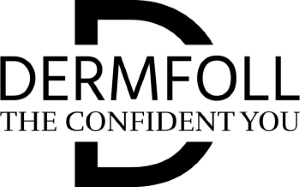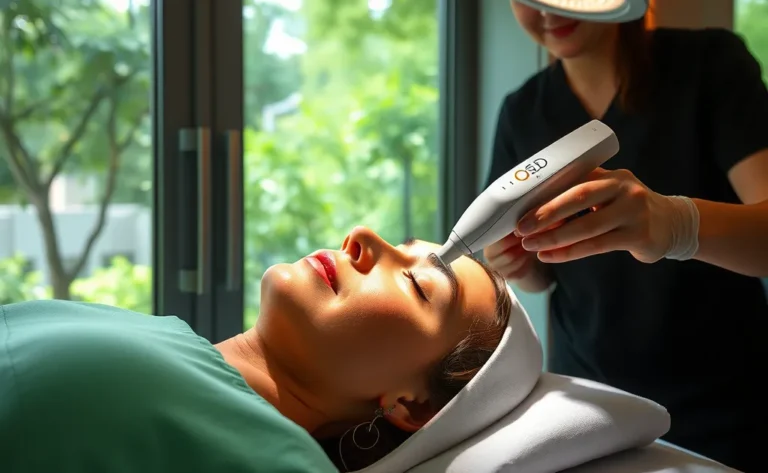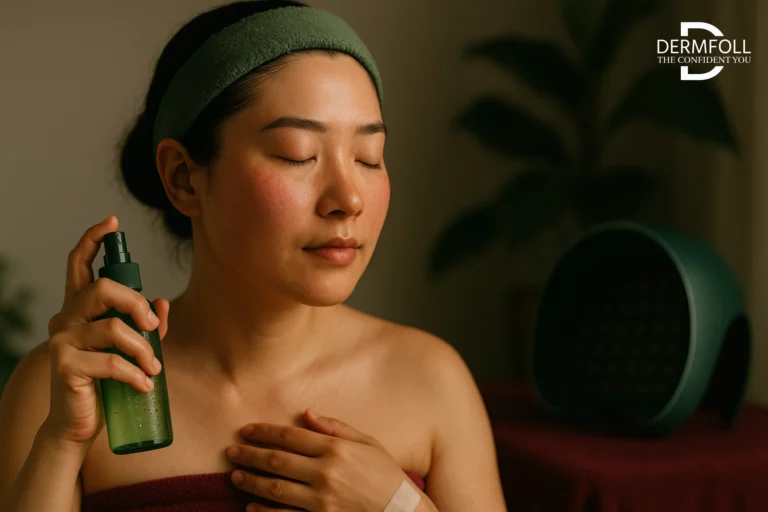A treatment that could transform your skin—reducing wrinkles, smoothing scars, and evening out your tone—all while fitting into your busy life? That’s exactly what fractional RF skin treatment offers. But as with any advanced procedure, you might be wondering, is fractional RF safe and right for you?
And break down how fractional radio frequency benefits make this treatment a go-to for improving skin health. Curious about how fractional RF and microneedling work together to deliver even better results?
Welcome to DERMFOLL. Here’s what you can look forward to:
- A breakdown of how fractional RF skin treatment works and why it’s so effective.
- Clear answers to help you understand: is fractional RF safe?
- How combining fractional RF and microneedling amplifies the results.
- Practical advice on recovery after a session.
What is fractional RF skin treatment?
Fractional Radiofrequency (RF) Therapy is a minimally invasive skin treatment that uses radiofrequency energy to create controlled microthermal zones in the dermis, sparing the surrounding tissues. This process stimulates collagen production, promotes skin tightening, and improves overall skin texture and tone while minimizing damage to the epidermis and reducing downtime.
Types of Fractional RF and Their Distinctions
Ablative vs. Non-Ablative Fractional RF Skin Treatment
Okay, hypothetically, you’re choosing between two skincare paths—one that’s a bold, transformative reset and one that’s a gentle, steady tune-up. That’s the difference between ablative fractional RF and non-ablative fractional RF treatments.
- Ablative fractional RF is like rebooting your skin’s system by creating tiny, controlled injuries on the surface. Triggering deep collagen remodeling, giving you dramatic skin resurfacing. Perfect for stubborn wrinkles, acne scars, or serious sun damage.
- Non-ablative fractional RF, on the other hand, skips the surface and focuses on delivering heat to deeper layers of your skin. This stimulates collagen production subtly, tightening your skin and improving texture over time. Minimal downtime means you’re looking at just a few hours of redness.
Here’s a snapshot of how they compare:
- Downtime: Ablative RF takes up to a week; non-ablative RF needs just a few hours.
- Best for: Ablative is your go-to for deep wrinkles and scars; non-ablative works wonders for mild texture concerns.
- Results: Ablative gives faster, more dramatic changes. Non-ablative is gentler and gradual.
Fractional Radio Frequency Benefits for Various Skin Concerns
No matter which option you choose, fractional RF offers incredible benefits. It’s a versatile tool for various skin concerns, including:
- Wrinkles: Boosts collagen to smooth fine lines and deeper creases.
- Scarring: Breaks down and remodels scar tissue and stimulates healthy collagen for acne, surgical, or trauma scars.
- Tone & Texture: Evens out hyperpigmentation, improves rough texture, and promotes cell turnover.
Plus, it’s safe for all skin types, including darker tones, and offers long-lasting results.
Fractional RF and Microneedling: A Powerful Combination
Want to supercharge your results? Combining fractional RF with microneedling might be the perfect solution. Think of microneedling as creating tiny pathways in your skin.
And fractional RF is delivering collagen-boosting energy through those pathways. Together, they tighten skin, refine texture, and tackle scars even more effectively.
This amplifies collagen stimulation and skin tightening, making it especially effective for:
- Deep wrinkles and scars: The synergy enhances the breakdown of scar tissue while encouraging regeneration.
- Improving texture: RF energy delivered through microneedles promotes smoother, firmer skin.
- Minimizing downtime: Insulated microneedles precisely target deeper layers, reducing damage to the surface.
Some standout devices that integrate these technologies include:
- Morpheus 8
- Genius
- InMode’s Fractora
- Endymed Intensif
- Lumenis Legend Pro
These advanced systems use insulated microneedles to deliver RF energy precisely where it’s needed. They help in reducing surface damage and speeding up healing.

Is Fractional RF Safe?
In short, yes, fractional RF skin treatments are generally considered safe. They come with a few common, temporary side effects, but serious complications are rare when performed by a qualified professional. Here’s what to expect:
- Redness: It’s normal for your skin to look a little flushed after the procedure. The redness usually fades in a few hours to a day.
- Mild Swelling: Some swelling, particularly around the treated areas, can occur but resolves in a day or two.
In rare cases, you might encounter:
- Infection: Following your aftercare routine is crucial to avoid this.
- Hyperpigmentation or hypopigmentation: People with darker skin tones or those undergoing ablative treatments may be more prone to this.
Studies back up the safety of fractional RF. They’ve shown significant improvements in skin elasticity, wrinkle reduction, and minimal risk of complications. As the treatment is done by skilled hands.
Who Is a Good Candidate for Fractional RF Skin Treatment?
Fractional RF is ideal for individuals looking to improve:
- Mild to moderate wrinkles
- Acne scars or other scarring
- Skin laxity
- Uneven skin tone or texture
It’s also a less invasive alternative to laser treatments, offering minimal downtime—a beneficial option for busy schedules.
Factors that may affect eligibility
- You’re using harsh skincare products like retinoids or exfoliants.
- You have active acne breakouts.
- You’re managing autoimmune disorders.
- You’re taking medications like isotretinoin, which can affect healing.
Does Skin Tone Matter?
Here’s the positive news: fractional RF is suitable for a variety of skin tones, including darker complexions.
Unlike some laser treatments, RF energy poses a lower risk of post-inflammatory hyperpigmentation (PIH).
That said, adjustments to the settings are important, so be sure your provider has experience tailoring treatments to diverse skin tones.
Preparing for Your Fractional RF Skin Treatment
Preparing your skin properly is the first step to ensuring a safe and effective treatment. Here’s how you can get ready:
- Avoid harsh skincare products: Discontinue retinoids, exfoliants, or any irritating products at least a week before your procedure.
- Protect your skin from sun exposure: Reduce sun exposure leading up to the treatment to minimize risks like hyperpigmentation.
- Consult your provider: Share details about medications, including isotretinoin or others, as these may need adjustments.

Recovery Timeline and Optimal Aftercare
Recovery from fractional RF skin treatment depends on the approach—ablative or non-ablative:
- Ablative RF: Recovery may take up to a week or more. Expect redness, swelling, and scabbing as the skin heals deeply.
- Non-Ablative RF: A faster recovery option, with mild redness or swelling fading within hours to a day.
Follow these tips for optimal aftercare:
- Hydrate and cleanse: Use gentle cleansers and moisturizing products to aid the healing process.
- Prioritize sun protection: Apply broad-spectrum sunscreen daily to prevent hyperpigmentation.
- No picking or scratching: Let your skin heal naturally to avoid infection or scarring.
Fractional Radio Frequency Benefits
The fractional radio frequency benefits are vast and versatile:
- Collagen stimulation: Boosts natural collagen production to reduce wrinkles and improve elasticity.
- Minimally invasive: Less downtime compared to laser treatments, making it ideal for busy schedules.
- Works for all skin types: Safe for darker skin tones, with lower risks of post-inflammatory hyperpigmentation.
- Targets multiple concerns: From scars and uneven texture to skin laxity, this treatment is highly effective.
Why a Professional Consultation Matters
Before jumping into any treatment, it’s critical to consult with a board-certified dermatologist or plastic surgeon. During this visit, they’ll:
- Assess your skin concerns and treatment goals.
- Review any medications or ongoing skincare routines.
- Customize the treatment to fit your skin type and needs.
This step ensures that fractional RF is not only safe but also effective for your unique skin.
Trends and Future Directions
The future of fractional RF skin treatment looks promising, with exciting innovations on the horizon:
- At-home RF devices: These portable options make it easier to maintain results between professional treatments. Be cautious to choose reputable brands and follow instructions for safety.
- AI-assisted RF devices: Artificial intelligence optimizes treatment settings based on your unique skin profile, offering personalized outcomes.
Other advances in combination therapies
- PRP (platelet-rich plasma): When combined with fractional RF, PRP enhances tissue regeneration and collagen growth using growth factors derived from your blood.
- LED therapy: RF paired with LED lights accelerates healing while addressing specific concerns like redness and acne.
As microneedling technology evolves, features like insulated needles are increasing the precision and safety of these treatments.
CONCLUSION
By now, you’ve seen how fractional RF skin treatment can be a game-changer for improving wrinkles, scars, and overall skin texture. With its powerful fractional radio frequency benefits and versatility…
Whether combined with microneedling for amplified results or used alone, it’s a safe and effective solution for many skin concerns.
But what about scars? Did you know that radiofrequency technology is also redefining how we treat everything from acne scars to surgical marks? If scars are a concern, this is the perfect time to explore what’s possible.
what’s your experience with skin treatments like this? Have you tried fractional RF and microneedling, or are you considering it for the first time? Share your thoughts, and let’s start a conversation about what’s worked for you.
In our next post, we’ll take a closer look at how radiofrequency technology is revolutionizing scar treatment. Offering new hope for smoother, healthier-looking skin. Stay tuned—you won’t want to miss it!








